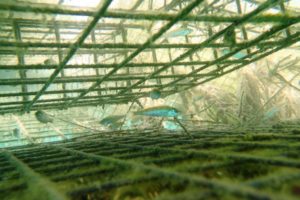Project UROS – French Alps (ongoing)
Artificial floating littoral zone (FLOLIZ)
Context
Lake ecosystems are of great interest to mankind, both for the water resources they represent, but also for their important terrestrial and aquatic biodiversity. The dependence of human activities on these environments has led to the artificialization of many natural lakes and the creation of a multitude of artificial reservoirs (79% of water bodies of more than 50 ha are artificial in France). These habitats are therefore particularly subject to destruction and this type of alteration is known to be the primary cause of biodiversity erosion in aquatic environments. The tidal range imposed on environments for hydroelectric or agricultural management is one of the primary factors.
Interests & Objectives
The UROS project was initiated with the French Agency for Biodiversity in order to find solutions to compensate for the deleterious effects of the tidal range on river ecosystems. The study area is the Serre-Ponçon reservoir in the Hautes-Alpes, which has an annual tidal range of about 30 meters. The interest of this project consists in compensating for the lack of riparian habitat of the reservoir by the means of 3 artificial and vegetated floating structures. These structures, each with a surface area of approximately 70m², provide a riparian zone and underwater habitats adapted to the tidal range. More than a simple vegetated raft, it is a real littoral zone floating on the lake. The objective is to offer habitats for local fauna and to recreate (naturally and artificially) ecological functions, notably nurseries and spawning grounds for fish.
Scientific monitoring
The scientific monitoring of the project has several goals: (i) to monitor the colonization of the UROS islands by aquatic macrofauna (fish and macroinvertebrates), but also by vegetation and birds, (ii) to evaluate the interest of such structures to support the lake biodiversity, (iii) to propose technical improvements to promote maximum functionality of the various artificial and natural habitats created. Finally, to offer a final architecture of the UROS islands optimizing the ecological cost/efficiency ratio, and to analyze the possibility of generalizing this type of solution to other French and European tidal ecosystems.












